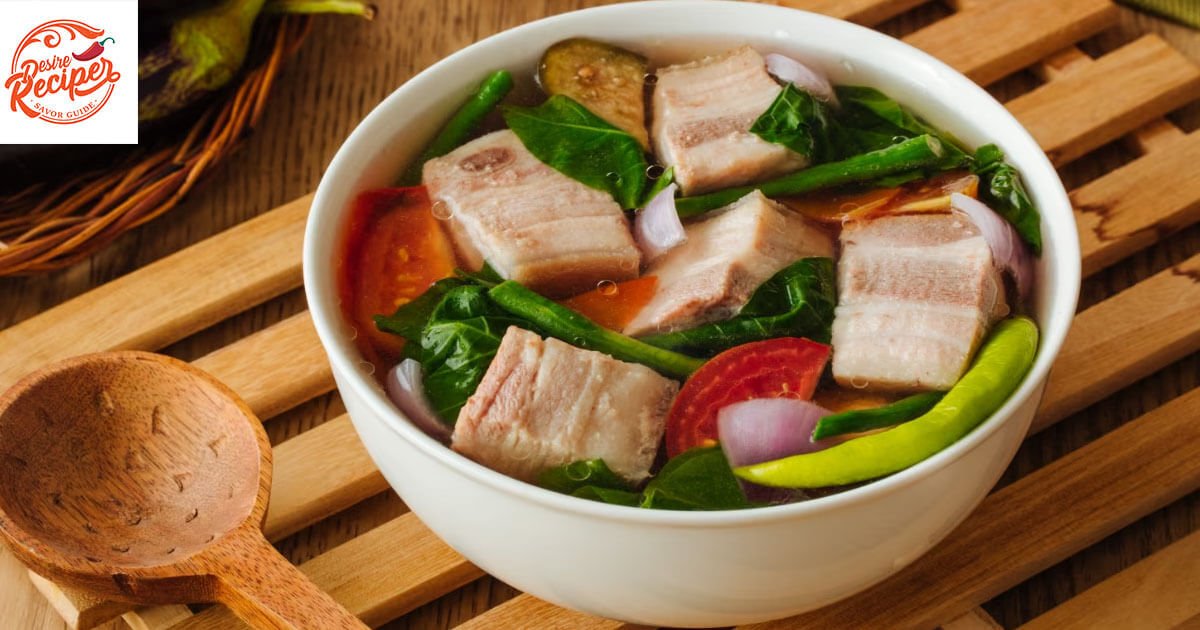Sinigang Recipe is a very popular and sour Filipino handmade soup with its special combination of sour and savory tastes. It is composed of many kinds of vegetables and meat that are boiled in sour tamarind broth, making it a cozy dish that can be eaten any day.
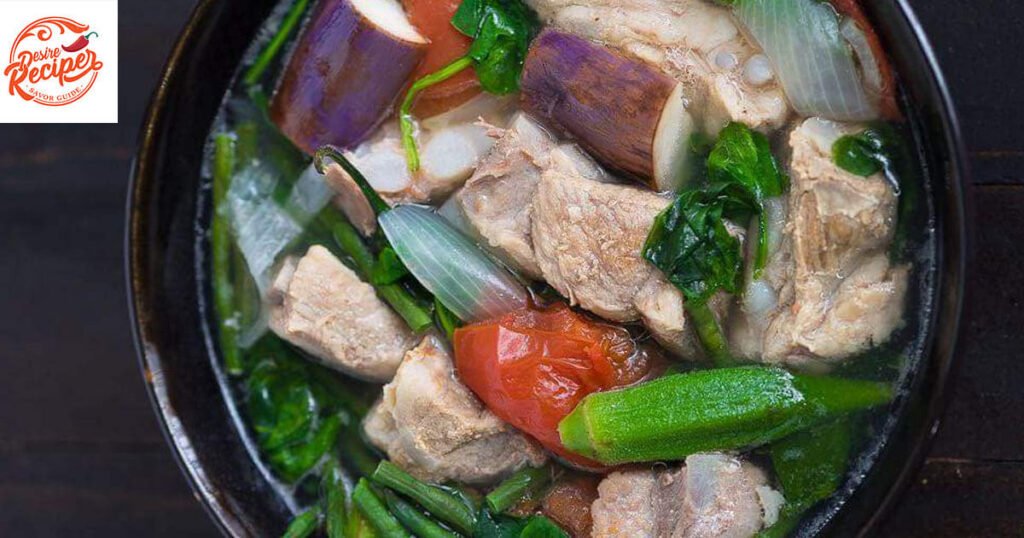
One of the easiest ways of making sinigang is this guide that is perfect for you, regardless of whether you are a novice in Filipino food or someone who wants to make a family classic another time. This will enable you to get the proper skills to cook this delicious dish in the cozy atmosphere of your own house.
What is Sinigang Recipe?
Tamarind makes the sinigang, a rich sour soup from the Philippines that is extremely sour, with the most sour flavor of the dish. On the other hand, it is a dish of various types of meat. Pork, beef, shrimp, and so on, while it also has a mix of legumes and vegetables such as radish, eggplant, and spinach.
Why Do People Love This Sinigang Recipe?
Sinigang, which is an entertaining dish that I know of, is the perfect combination of sour and salty. It is among the simplest dishes one can ever cook. Its taste is deep, comforting, and strong, so it can be eaten in any context. The ingredient’s possibility also permits the creation of a new recipe, and that’s why it is a beloved dish in family kitchens.
Ingredients of Sinigang Recipe
To make pork sinigang, gather these ingredients:
- 1.5 lbs pork belly or ribs, cut into chunks
- 1 large onion, quartered
- 2 medium tomatoes, quartered
- 8 cups of water
- 1 packet tamarind soup base or 1/2 cup fresh tamarind pulp
- 2 radishes, sliced
- 1 eggplant, sliced
- 1 cup string beans, cut into 2-inch pieces
- 2 cups water spinach (kangkong) or regular spinach
- 3 green chili peppers (optional, for added heat)
- Fish sauce or salt, to taste
- Pepper, to taste

Instructions
Step 1: Prepare the Ingredients
The foremost and crucial move in preparing an enticing dish is the collection of the precise components. Commence the process by chopping the pork into miniature cubes. thereafter, partition the onion and tomatoes into four pieces each, and finally, create the radish and eggplant slices. Cut the string beans into 2-inch-long pieces and rinse the spinach well.

Step 2: Boil the Meat
To begin, the pork cut is immersed in a cooking pot filled with water to the maximum level so that the pieces of pork are completely under the ocean. The burner should be at its maximum setting, and the chef should keep waiting for the water to bubble; at this moment, the water should be boiling. When it comes to the point, turn the heat down to low and let it simmer for about thirty minutes. To lap the broth, scraping the scum which is the dirt that floats on the surface of the pot is necessary.
Step 3: Add the Aromatics
Add the onion, cut into quarters, and the tomatoes to the pot. Let them sit for a further 10 minutes to simmer so that the taste mixes well.

Step 4: Incorporate the Tamarind
You have the option of adding either the ready-made tamarind soup base or the fresh tamarind pulp to the pot. The idea behind making sure that they dissolve and mix properly is to stir them very well. As for fresh tamarind, you may have to strain the pulp if you want to get rid of the seeds and fibers.
Step 5: Add the Vegetables
Throw in the radish slices and allow them to be fried for about 5 minutes. Next, come the eggplant and string beans. Prepare until the vegetables are soft, roughly 10 minutes.
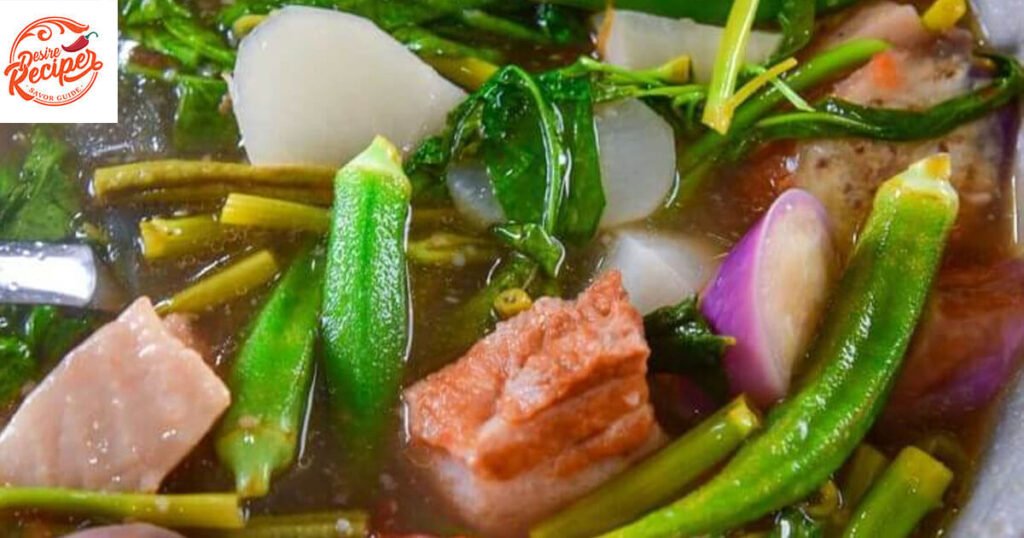
Step 6: Season the Soup
Dress your sinigang with fish sauce, salt, and pepper to taste. In case you would like a somewhat hot seasoning, put the green chili peppers.
Step 7: Final Touches
Lastly, you should include the spinach in the pot. Since spinach has a fast cooking time, you only need to leave it to wilt for a minute or two before you turn off the fire.
Step 8: Serve
Accompany your sinigang with a steaming side of white rice and enjoy it hot. The combination of the sour broth, soft meat, and tasty greens forms this exquisite balance that your taste buds will surely love.

Tips for the Best Sinigang Recipe
- Choose the Right Meat: Pork belly and ribs are popular choices because they add a rich flavor to the broth. You can also use beef, shrimp, or fish if you prefer.
- Fresh Tamarind vs. Tamarind Soup Base: The fresh tamarind alternative makes the dish taste authentic, however, the tamarind soup base is an easier option.
- Adjust the Sourness: The measure of sourness that you would prefer can be realized by the correspondingly increasing/decreasing amount of the tamarind fruit that you use. Broth with More.
- Add More Vegetables: Besides the main vegetables, you are also encouraged to use taro, red bell pepper, and squash, which will additionally improve the taste and the appearance of the meal.
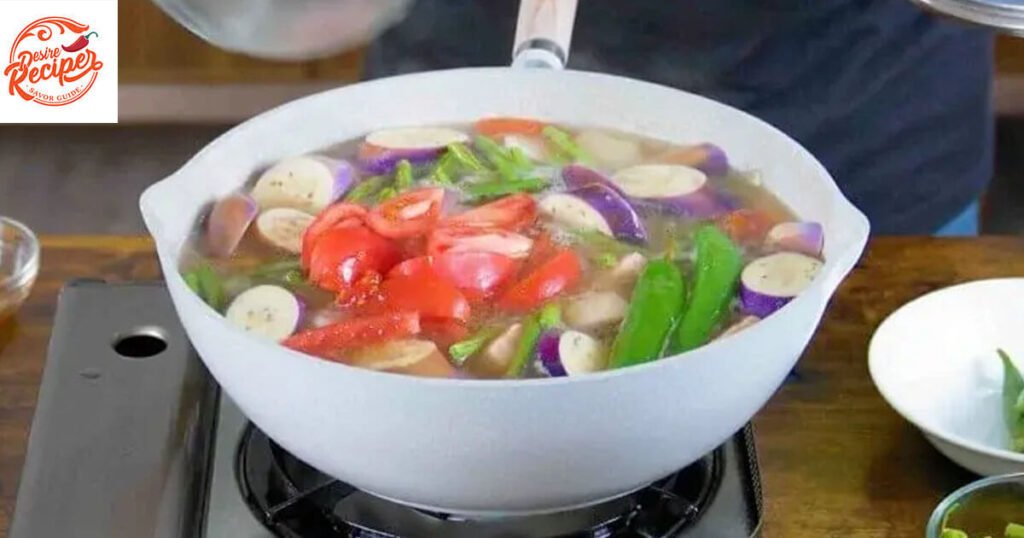
How to Store Sinigang Recipe?
To keep the sinigang, at first, you have to cool it down to room temperature and then put it in an airtight container. The refrigerator lets you store it for three more days. You can reheat the soup by just bringing it to a boil on the stove. Should the soup become too thick, you can add a little water to adjust it to your preferred thickness.
FAQS
Can I Use Other Types of Meat?
Sinigang can be prepared using shrimp or along with fish as its main ingredients instead of being cooked separately with beef. The given time to cook the meal is likely to change according to the type of meat that is being specially added. For example, inanga takes a longer time to be cooked because it needs to be salted properly, unlike shrimp and fish. On the other hand, shrimp and fish are easily cooked.
What Other Vegetables Can I Add?
Along with the common vegetables that are precooked for the dish, such as radish, eggplant, or spinach, you can also add other vegetables like squash, taro, and even green beans. You might also use your own loved vegetables to prepare a sinigang, which is only yours to make.
Can I Make Sinigang Recipe Without Tamarind?
You can switch to other souring agents, such as lemon or lime juice, green mango, and vinegar, to complete the dish, as Tamarind is currently out of stock. But then again, there is no way to conceive the authentic flavor of the dish made of tamarind.
Lemon or lime juice, green mango, and vinegar can be used as other alternatives to replace the tamarind. Yet, without the use of tamarind, you can never come close to the actual taste of the specific dish.
Conclusion
A dish is sinigang, not just a soup; it is an offering of warmth and comfort to anyone who tastes it. Its distinctive sour and salty fusion makes it one of the most characteristic dishes of Filipino cuisine. Making this easy sinigang recipe at home is a way for you to experience a bit of Philippine culture in your kitchen.
Savor your fork, marvel singing, and do not forget to share this recipe with your friends and family on the list, they might want to have a shot at this great dish as well!
Recipe!
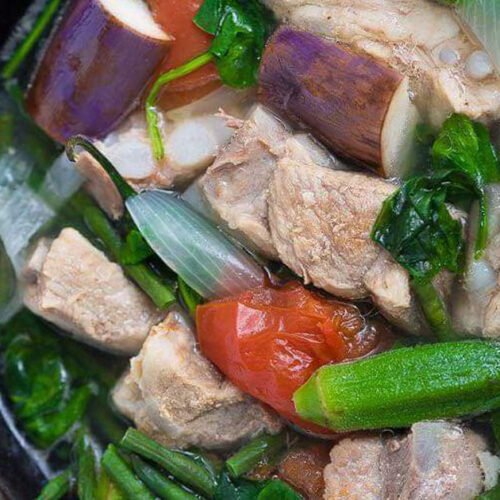
Homemade Sinigang Recipe
Equipment
- Dutch oven
- Mixing bowls
- 9×13-inch baking dish
- pan
Ingredients
- 2 ibs pork belly see notes
- 1 ib young tamarind see notes
- 1 bunch water spinach chopped
- 8 pieces string beans cut into 2-inch pieces
- 2 pieces eggplants sliced
- 1 piece daikon radish see notes
- 8 pieces okras
- 2 pieces tomatoes
- 1 green pepper
- 1 onion
- Fish sauce and ground black pepper to taste
- 2 quarts Water
Instructions
- Boil the young tamarind in 2 quarts of water for 40 minutes. Filter the tamarind broth using a kitchen sieve or a strainer. Squeeze the tamarind afterward to extract its remaining juices.1 lb. young tamarind, 2 quarts water
- Pour the tamarind broth into a cooking pot. Let it boil and then add the onion, pork belly, and half the amount of the tomatoes.2 lbs. pork belly, 1 piece onion, 2 pieces tomatoes
- Skim off the floating scum, pour 1 tablespoon fish sauce, cover and continue to simmer for 1 hour. Fish sauce and ground black pepper
- Add daikon radish and eggplants. Cook for 5 minutes.1 piece daikon radish, 2 pieces eggplants
- Add the long green pepper, string beans, remaining tomatoes, and okra. Cook for 3 minutes.8 pieces string beans, 2 pieces tomatoes, 2 pieces long green pepper, 8 pieces okras
- Add the chopped water spinach stalks and season with fish sauce and ground black pepper. Cook for 2 minutes. Fish sauce and ground black pepper
- Put the water spinach leaves. Cover and turn the heat off. Let the residual heat cook the leaves for 3 minutes before serving.1 bunch water spinach.Share and enjoy!
Notes
Notes
- Pork Belly – This is the best cut to use when cooking sinigang, in my opinion. The fat in the belly makes the meat moist which complements well to its tenderness. The other cuts of pork that I use are: pork shoulder, spare ribs, and pork neck bones.
- Young Tamarind – Use only young tamarind if you want your soup to be sour. However, a combination of both young and ripe tamarind can be good too, especially if you like your soup to have a hint of sweetness.
- Daikon Radish – This is an optional ingredient for sinigang.
- Taro (gabi) – Adding taro to the dish will make the soup thicker. This is a version of the dish known as sinigang na baboy with gabi.
